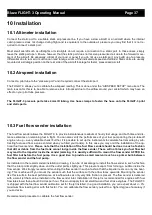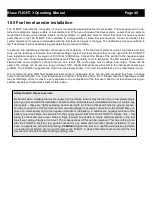
Blaze FLIGHT-3 Operating Manual
Page 40
10.5 Fuel level sender installation
The FLIGHT-3 permits the connection of one or two standard automotive fuel level senders. These senders can be ob-
tained at automotive spares outlets at reasonable cost. When you choose a float level sender, ensure that you select a
model that is sturdy and promises reliable and long lifetime. In particular, select a model that does not have any metal
parts that can rust. The FLIGHT-3 can interface to a large variety of these fuel level senders. It does not matter if the
sender resistance increases or decreases with the fuel level as long as it changes. The calibration procedure outlined in
the “Fuel Setup” section describes in great detail the procedure to follow.
In essence, the calibration procedure will measure the resistance of the fuel level sender at various fuel levels and then
work out the readings in between those known settings. Typical fuel level senders that can be used with the FLIGHT-3
have resistance ranges in the region of 100 ohms to 500 ohms. Connect the flange of the sender to the negative supply
(ground). You can connect capacitive senders as well. These generally come in two types: The first emulates a normal re -
sistive probe and is simple to connect and use as a result. The second type has a voltage level output. These can be
used if the voltage can be set to a range of about 0-5V. Higher voltage levels will result in the instrument assuming a
problem. The FLIGHT-3 supports one or two fuel tank level senders. You need to enable these in the “Fuel Setup” menu.
We recommend using VDO float based fuel level senders. Capacitive types can be used provided they have a voltage
output not exceeding 5V. The level terminal has an internal 1K resistor pull-up to 5V. Please note that capacitive senders
may exhibit large errors as they are very sensitive to the composition of the fuel used. We do not recommend using ca -
pacitive senders with automotive fuels for this reason.
Safety Hazard! Please take note:
Be careful when installing fuel level senders into fuel tanks. Ensure that the fuel tank is completely empty
when you proceed with the installation. Ensure that the fuel tank is well ventilated and does not contain any
fuel vapors – these are highly explosive when mixed with air. Ensure that at all times the ground connec -
tion (the connection of the fuel level sender mounting flange) is securely connected to the aircraft frame (in
case of a metal frame) and to the negative terminal of the battery. In addition the negative terminal of the
battery must at all times be connected to the supply ground terminal of the FLIGHT-3. Please note – this
wiring is critical and must never break in flight. It would be possible to create electrical sparks in the fuel
tank if your wiring is faulty or incorrect. The consequences of this can be imagined. This has nothing to do
with the FLIGHT-3 itself but is a general hazard for any automotive fuel level sender installation. If you
have no experience with electrical wiring,
PLEASE
delegate the task to a qualified automobile electrician
or electronics technician. If you need to remove the FLIGHT-3, please first disconnect and secure the fuel
level sender wire before disconnecting anything else.


























